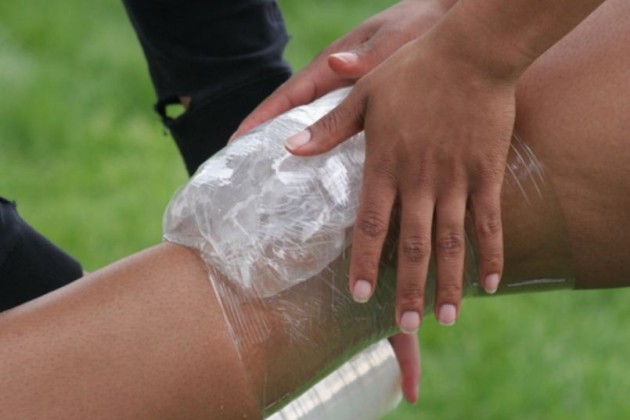
Ice pack to help heal an injury
Sprain symptoms and treatment
It’s the joints that get sprained and you can help to heal the injury with ice. The sprained joint will feel hot and look swollen and bruised
Examples of types of sprains
– Ankle sprain
– Knee ligament injury
– Wrist sprain
– Skiers thumb
Strains and treatment
You strain muscles and just as with sprains, you can help to heal the injury with ice. The muscle will feel painful and sometimes look bruised. Due to gravity, this bruising sometimes tracks to the next joint.
Examples of types of strains
– Tennis elbow
– Rotator cuff injury
– Pulled calf muscle
– Hamstring strain
Aches and pains
Aches and pains occur as a result of long standing injuries and degenerative conditions e.g. arthritis. This is where you would use heat to help heal the injury.
How to help heal an injury with ice
Use ice on acute injuries. An acute injury is one that you have done recently, e.g. if you have an ankle sprain or a pulled calf muscle.
Ice is also useful if you are having an acute flare up of a chronic injury – for instance you know you have an arthritic knee, but have walked further than normal today making the joint sore and painful.
The use of ice slows down the blood flow to the area reducing the amount of swelling around an injury.
Ice is particularly effective if applied in elevation as gravity will also help to decrease the swelling. The injured part needs to be higher than your heart. e.g. if you have an ankle sprain, lie on the floor and put your foot up on a stool or the sofa.
If I have a pulled calf muscle, how would I apply ice?
The best method is to place a pack of frozen peas on your pulled calf muscle.
It’s uncomfortable and easy to give yourself an ice burn if you put the ice directly onto the skin, so instead run a tea towel under the tap, wring it out, wrap the bag of peas in the tea towel and then apply to the skin. Even better rub a little baby oil onto the skin first.
If your injured area is too small to balance a bag of peas, e.g. if you have skiers thumb take an ice cube and rub it over the area. This is known as ice cube massage.
How long do I leave the ice on for?
Ice has its maximum effect in the first twelve minutes. Leaving the ice on for longer will gain you no benefit, but risks damaging the skin and in extreme cases could even cause frost bite.
How often can I apply ice?
Give the area chance to recover its normal temperature between treatments, but up to once every hour would not harm. Most people find three times a day in the first days after injury enough.
The peas can be refrozen and used as an ice pack over and over, but remember not to mix then up with the ones you are planning to have for tea!
When should I not use ice?
Don’t use ice if your circulation is poor.
Be careful using ice if your skin is in a poor condition or if you have cuts and abrasions.
Should I treat my injury with heat?
Heat is best used on chronic injuries. Chronic injuries are ones that you have had for more than a few weeks. e.g. arthritis and long standing injuries.
Heat increases the blood flow to the area, and relaxes muscles.
Don’t use heat on an injury that has happened in the last 48 hours (an acute injury). There may still be bleeding into the area and heat will make this worse.
Don’t use heat as a preventative measure immediately after sport.
Check out more Physiotherapy articles.
Read news from our Interviews section, every Tuesday a new story! Tomorrow read about Jelena Nikolic’s return to court.